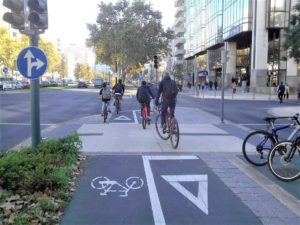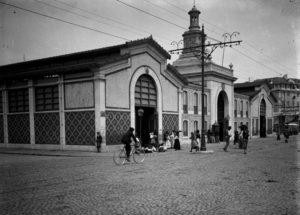Portugal’s capital city, Lisbon may not be the most obvious case study for a cycling city. Bicycle ownership numbers, between the 1920s and late 1960s, show the seaside area of Aveiro, where the metal industry has been thriving in producing bicycles parts, together with districts like Porto and Coimbra, historically leading in cycling. Lisbon lagged behind, even when considering that more people lived in the city. Between the 1880s and 1910s, Lisbon had a thriving cycling culture spearheaded by the Portuguese Velocipedic Union (established in 1899). Since 2009, new cycling associations and activism have revived cycling and have succeeded in helping local and national administrations in revising regulations, constructing new cycle ways , and implementing a public bike-share program (GIRA).
Like elsewhere, the source-rich period of the bicycle craze in the 1880s evaporated from the historical record in the mid-1910s, creating the notion that cycling too disappeared. Our preliminary research of alternative historical sources such as local newspapers, photographs, commerce yearbooks, advertising and urban planning records of roads, sidewalks, and parks, however, reveal the forgotten history of cycling in Lisbon. Our study will broaden the scope to understand the diversity of cycling cultures in the larger Lisbon Metropolitan Area including the leisure area of Estoril and the industrial south bank of the Tejo River.
These historical sources show how cycling levels remained consistent. In the 1930s, for example, the bridge planners for the Tejo river projected that bicycles would have a significant share in the traffic crossing the bridge of approximately 50 percent compared to cars. The first traffic counts for national highways in 1937 suggest that cycling was often more popular than cars in some Lisbon district roads. And cycling also had a significant uptake after the Second World War, when fuel shortages limited motorized mobility. Since the 1960s, motor cycling and the family car has been displacing cycling.
Our research group will examine five factors of the Cycling Cities project to understand the ups and downs of cycling history in Lisbon from the enticing bicycle bell of the one-man metal repairs business (Amolador’) to many other service people who used bicycles for their jobs including military personnel, postmen, and policemen as well as ice-cream seller, chestnut vendors, and other types of salespersons. We look at the sites where Lisbon citizens first began to cycle in the 1880s, ranging from the Campo Grande park and the Terreiro do Paço square to the scenic touring route of the 1940s coastal road, connecting Lisbon to Cascais, and the Monsanto forest, Lisbon’s 1970s planning for a green “lung” (Corredor Verde), green urban spaces that today serves as an anchor for the city’s most recent cycling policy.

Research team
M. Luísa Sousa is an assistant professor and a research fellow at the Interuniversity Centre for the History of Science and Technology (CIUHCT) at the NOVA University of Lisbon, working on the post-World War II development of highway engineering. She was the PI of the research project Hi-BicLab – History Lab for Sustainable Urban Mobilities: Lisbon’s cycling policies (2022-2024).
João Machado is a research fellow at the Interuniversitary Centre for History of Sciences and Technology (University of Lisbon) and contributed to Making Europe. Technology and Transformations, 1850-2000 (Palgrave). He is currently doing his PhD dissertation on History of Computing in Portugal during the 1980s.
Bernardo Pereira is an architect (University of Waterloo School of Architecture, Canada), mobility and public space specialist in Lisbon, with a PhD on public policy regarding urban cycling, realised at University of Aveiro.
David Vale is an associate professor at Lisbon School of Architecture, University of Lisbon, teaching courses such as Urban Geography, Road Systems and Transportation, and Geographic Information Systems. His research is focused on the integration of land use and transportation, and on the integration of different transport modes, with a special focus on transit-oriented development and walking and cycling.
Jaume Valentines-Álvarez is an associate professor and research member of the History of Science Institute at the Universitat Autònoma de Barcelona. He is interested on the epistemic politics of activism and the community construction of technology. He worked at the Lisbon’s Interuniversity Centre for the History of Science and Technology from 2014 to 2022. He still misses cycling in Lisbon.
Diego Cavalcanti is a PhD student in History, Philosophy, and Heritage of Science and Technology at NOVA FCT (Portugal), with funding from the Fundação para a Ciência e a Tecnologia (FCT). He holds a Master’s degree in Social History from the Federal University of Ceará (Brazil), supported by a CAPES scholarship. His research interests include urban mobility, urban history, and the history of science and technology.
Patrícia Melo is an associate Professor in Economics at ISEG Lisbon School of Economics and Management of the University of Lisbon. She previously worked at the James Hutton Institute in Aberdeen and at Imperial College London. Her main research interests relate to urban and regional economics and transport economics.
Funding and partners
We want to thank all the funders and participating institutions that made this book possible!
Cycling Cities: The Lisbon Experience was financed by the Portuguese Research Council (Fundação para a Ciência e a Tecnologia) through national funds. The book was funded by one research project: the History Lab for Sustainable Urban Mobilities: Lisbon’s cycling policies. Additionally, through PIDDAC (Programa de Investimentos e Despesas de Desenvolvimento da Administração Central) the book was part of three research units:
- CIUHCT (Interuniversity Center for the History of Science and Technology)
- CIAUD (Research Centre for Architecture, Urban Planning and Design)
- REM, UECE (Research in Economics and Mathematics)
Other participant institutions and projects we would like to thank are:
- FCT NOVA (NOVA School of Sciences and Technology, Universidade NOVA de Lisboa)
- FAUL (Lisbon School of Architecture, Universidade de Lisboa)
- ISEG/ULisboa (Lisbon School of Economics and Management, Universidade de Lisboa)
- Universidade de Aveiro
- Research project Exchange Zones of Epistemic Resistance and Alternative Innovation: Activism, Grassroots Movements and Expertise, 1970s-1990s, Ministerio de Ciencia, Innovación y Universidades.
